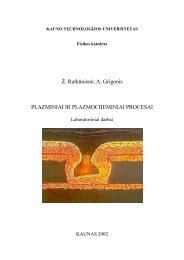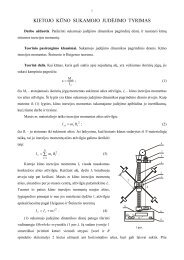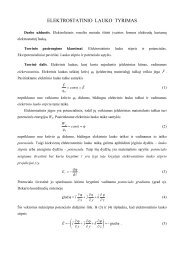PROCEEDINGS OF THE 7 INTERNATIONAL ... - Fizika
PROCEEDINGS OF THE 7 INTERNATIONAL ... - Fizika
PROCEEDINGS OF THE 7 INTERNATIONAL ... - Fizika
You also want an ePaper? Increase the reach of your titles
YUMPU automatically turns print PDFs into web optimized ePapers that Google loves.
MEDICAL PHYSICS IN <strong>THE</strong> BALTIC STATES 7 (2009)<br />
Proceedings of International Conference “Medical Physics 2009”<br />
8 - 10 October 2009, Kaunas, Lithuania<br />
PPI DENDRIMERS ENCAPSULATED WITH SILVER NANOPARTICLES AS<br />
CARRIERS FOR MEDICAL APPLICATIONS<br />
Marius FRANCKEVIČIUS<br />
Liquid Crystals Laboratory, Faculty of Physics and Technology, Vilnius Pedagogical University, Studentu 39, LT-<br />
08106 Vilnius, Lithuania.<br />
Email: marius.franckevicius@yahoo.com<br />
Abstract: Poly(propylene-imine) PPI dendrimers incorporated with silver nanoparticles were studied. Optical spectra of<br />
fourth generation liquid crystalline poly(propylene-imine) PPI dendrimer with antimicrobial silver nanoparticles in<br />
chloroform solution were investigated. Shift of plasmon resonance peak towards to IR region about 20 nm in the liquid<br />
crystalline poly(propylene-imine) PPI-silvernanoparticle system was observed.<br />
Keywords: liquid crystalline dendrimers, encapsulated dendrimers, silver nanoparticles, absorption<br />
1. Introduction<br />
Nanoparticles have distinguished possibility to be<br />
applied for diagnostics and targeted therapy. There exist<br />
many nanostructures with possible applications for<br />
targeting into cell, but in this study we orient on to<br />
dendrimers, which are soft polymeric nanostructures<br />
that offer structural flexibility and possibility to<br />
incorporate nanoparticles [1].<br />
Dendrimers are perfect biofriendly, non-toxic,<br />
monodisperse organics macromolecules, with highly<br />
branched, and well defined chemical structure [2].<br />
Dendrimers are a relatively new group of polymeric<br />
macromolecules, and have considerable interest to<br />
biomedical researchers because of their desired<br />
properties manipulation possibility during the synthesis.<br />
All bonds in dendrimers emerge radially from a central<br />
core to which monomers are attached. For the synthesis<br />
of dendrimers divergent and convergent strategy can be<br />
applied, therefore periphery and interior of dendrimer<br />
can distinguish big differences in features. Chemical<br />
and physical properties of dendrimers can be varied and<br />
optimized, therefore they show potential for medical<br />
applications. Typical size of these compounds varies<br />
from 1 to about 10nm [3] that it’s possible to diffuse<br />
dendrimers through biological membranes [4].<br />
Comparing lower generation dendrimers with higher<br />
generations tend to adopt spherical surface containing<br />
empty spaces in the interior. The empty spaces could<br />
host a guest molecules, drugs or nanoparticles [5]. This<br />
feature is very important when we talk about dendrimers<br />
as drug carriers, templates for nanoparticles synthesis<br />
and possible holders in wide range of nanosized<br />
materials. Drugs can be covalently coupled to the<br />
34<br />
dendrimer surface or complexed within the interior<br />
because there are many terminal groups to which drug<br />
molecules can be conjugated. Encapsulation of drugs<br />
inside dendrimers offer potential benefits such as<br />
prolonging the circulation time in the blood, protecting<br />
unstable drugs from the environment, enhancing the<br />
solubility of poorly soluble drugs, achieving controlled<br />
release and tissue targeting.<br />
It’s also known that silver is efficient antimicrobial<br />
agent [6, 7]. Therefore usefulness of these low toxic,<br />
noble metal nanoparticles is very important for medical<br />
applications. On other hand silver nanoparticles exhibit<br />
the highest efficiency of plasmon resonance of all other<br />
known metal nanoparticles. Optical properties of metal<br />
nanoparticles originate from collective oscillations of<br />
conductor electrons, which are termed surface plasmon<br />
polariton resonances after excitation by<br />
electromagnetics radiation [8]. There exist many works<br />
in which optical properties of silver nanoparticles were<br />
studied [9, 10].<br />
Recently were demonstrated, dendrimers are an<br />
effective polymeric cage for the preparation noble metal<br />
nanoparticles – referred as dendrimer metal<br />
nanocomposites [11]. Metal nanoparticles can be<br />
formed in the dendrimer interior or on periphery, it’s<br />
depending on the metal which is used to the synthesis,<br />
the type of reaction core and on the peripheral<br />
functional groups of the dendrimer [12].<br />
In some cases hybrid systems when they are composed<br />
from organic-organic or organic-inorganic composites<br />
are very interesting for many applications: in membrane<br />
technology, drug delivery, sensors technology and etc.<br />
[13]. Synthesis of these hybrid systems were described<br />
and characterized by some groups for different








